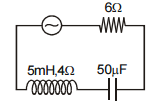The AC source in the circuit shown in the figure produces a voltage \(V = 20\cos(2000t)\) volts. Neglecting source resistance, the voltmeter and ammeter readings will be (approximately):

1.
\(4~\text{V}, 2.0~\text{A}\)
2.
\(0~\text{V}, 2~\text{A}\)
3.
\(5.6~\text{V}, 1.4~\text{A}\)
4.
\(8~\text{V}, 2.0~\text{A}\)

An AC ammeter is used to measure the current in a circuit. When a given direct current passes through the circuit, the AC ammeter reads \(6\) A. When another alternating current passes through the circuit, the AC ammeter reads \(8\) A. Then the reading of this ammeter if DC and AC flow through the circuit simultaneously is:
1. \(10 \sqrt{2}\) A
2. \(14\) A
3. \(10\) A
4. \(15\) A
If \(q\) is the capacitor's charge and \(i\) is the current at time \(t\), the voltage \(V\) will be:

| 1. | \(L \frac{di}{dt}+{iR}-\frac{q}{C}=V\) |
| 2. | \(L \frac{di}{dt}-{iR}+\frac{q}{C}=V\) |
| 3. | \(L \frac{di}{dt}+{iR}+\frac{q}{C}=V\) |
| 4. | \(L\frac{di}{dt}-{iR}-\frac{q}{C}=V\) |
A direct current of \(5~ A\) is superimposed on an alternating current \(I=10sin ~\omega t\) flowing through a wire. The effective value of the resulting current will be:
| 1. | \(15/2~A\) | 2. | \(5 \sqrt{3}~A\) |
| 3. | \(5 \sqrt{5}~A\) | 4. | \(15~A\) |
An \(LCR\) series circuit with \(100~\Omega\) resistance is connected to an AC source of \(200\) V and an angular frequency of \(300\) rad/s. When only the capacitance is removed, the current lags behind the voltage by \(60^{\circ}.\) When only the inductance is removed, the current leads the voltage by \(60^{\circ}.\) Calculate the power dissipated in the \(LCR\) circuit.
1. \(200\) W
2. \(400\) W
3. \(300\) W
4. zero
An ideal resistance \(R\), ideal inductance \(L\), ideal capacitance \(C\), and AC voltmeters \(V_1, V_2, V_3~\text{and}~V_4 \)

| 1. | Reading in \(V_3\) = Reading in \(V_1\) |
| 2. | Reading in \(V_1\) = Reading in \(V_2\) |
| 3. | Reading in \(V_2\) = Reading in \(V_4\) |
| 4. | Reading in \(V_2\) = Reading in \(V_3\) |
A transistor-oscillator using a resonant circuit with an inductance \(L\) (of negligible resistance) and a capacitance \(C\) has a frequency \(f\). If \(L\) is doubled and \(C\) is changed to \(4C\), the frequency will be:
1. \(\frac{f}{4}\)
2. \(8f\)
3. \(\frac{f}{2\sqrt{2}}\)
4. \(\frac{f}{2}\)
| 1. | \(50\) V | 2. | \(50 \sqrt{2} ~\text{V}\) |
| 3. | \(100\) V | 4. | \(0\) V |
In the circuit shown, the AC source has a voltage
\(V= 20\cos(\omega t)\) volts with \(\omega = 2000\) rad/s. The amplitude of the current will be nearest to:

1. \(2\) A
2. \(3.3\) A
3. \(\frac{2}{\sqrt{5}}\) A
4. \(\sqrt{5}\) A
| 1. | about \(14~\text{A}\) | 2. | about \(28~\text{A}\) |
| 3. | about \(20~\text{A}\) | 4. | cannot say |


